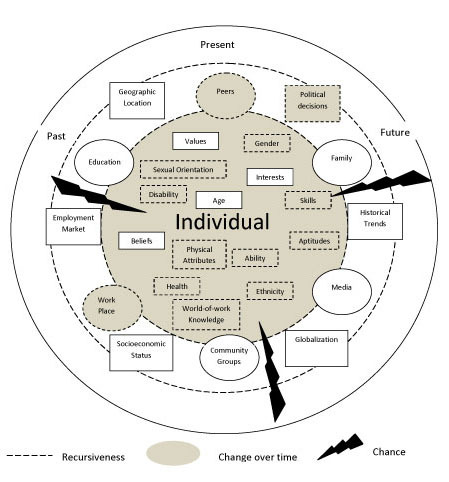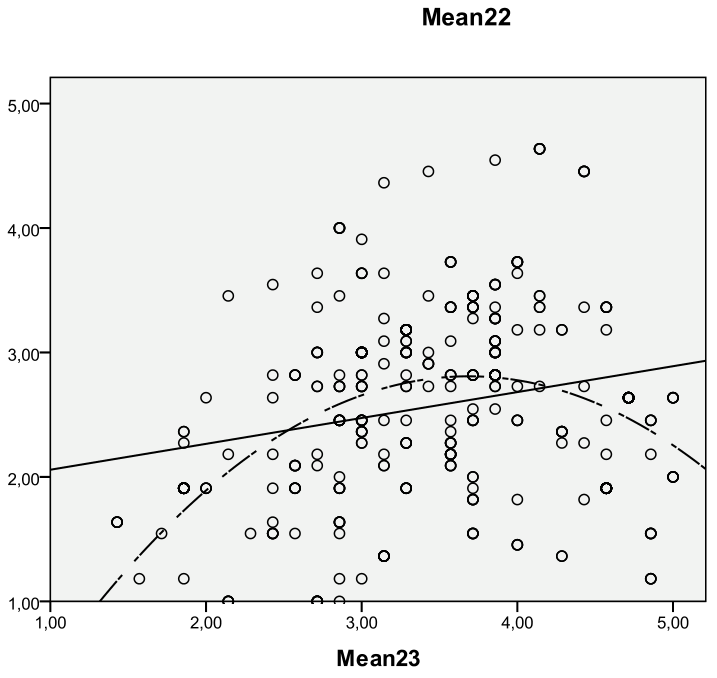Abstract
This paper is focused on discussing youth perception on career counselling services, with the purpose of delineating best practices in active employment behaviour engagement. The main purpose of current study is to analyze the dynamic relationship between perceived employment success and perceived employment assistance in career counselling of 432 youth, last year students from Romania, Turkey, Hungary and Cyprus. The curvilinear relationship highlighted demonstrates that very high and very low scores on perceived employment success are related to a negative perception of employment assistance, while situating on the medium response scores, and gives youth incentives for a positive perception and acceptation of employment assistance, which instead will work in their favour. Perceived employment success and perceived employment assistance prove to be crucial concepts when directly working with clients, because depending on these two perceptions the first beliefs of trust or distrust the career counselling process are formed. Results can be easily approached by the Systems Theory Framework (STF) of career development (
Keywords: Youthcareer counsellingSystems Theory Frameworkdynamic relationshipperceived employment successperceived employment assistance
Introduction
The Systems Theory Framework (STF) offers a guide for understanding the core concepts of
career counselling traditionally built on the foundation of career theory and counselling theory.
Traditional career theory has been focusing on specific discrete concepts relevant to individual system,
intrapersonal aspects such as self-concept, and other aspects being overlooked, undervalued or ignored,
along with their nature of interactions. This new perspective acknowledges interaction between system
inputs in terms of dynamical and complex instead of static and linear.
Systems Theory Framework (STF) has been proposed as a potential overarching framework for
dealing with applying theory into practice in the field of career counselling. Patton and McMahon (1999,
2006) have extended the utility of systems theory in a metatheoretical framework for career theory,
mainly designed to redefine career counselling practice. The Systems Theory Framework (McMahon,
2002; McMahon & Patton, 1995; Patton, 1997; Patton & McMahon, 1999, 2006) represents more than a
theory of career development, positioning all career development concepts effectively in both theory and
practice approaches.
According to STF, each individual has their own set of characteristics (i.e. gender, race, age,
beliefs, values etc.) some of which are permanently designed, while others are influenced by the context
in which the individual activates. All these characteristics form the individual level, the first level.

The second system, the social system is composed by components that can directly influence the
individual system like peer group, family and media. The third system is represented by the
environmental-societal system, related to particularities like geographical location, employment market
specificities and socioeconomic context. Although this outer system is often outside of the individual’s
control, having less direct influence on the individual system, it is often fundamental to the creation of the
client’s life design and perceptions. This system allows for recursiveness events to happen, changing
situations over time and chance events occurring, like in any other dynamical system.
Methodology
The focus of the present study is to apply the principles of systems theory framework approach in
the present career counselling activity, with the purpose of testing the dynamical relationship between
two core concepts: perceived employment success and perceived employment assistance, a dynamic
career counselling approach.
This study has been performed under an Erasmus project that was focused on the needs of the
unemployed youth in the countries of the participating organizations: Romania, Turkey, Hungary,
Cyprus, aiming to improve the quality and accessibility of educational and training provisions through the
use of ICT as well as to provide new skills for gaining long term employment. The aim of the
questionnaire used was to point out young people’s identification of vocational counselling needs,
unemployment statistics, relevant competencies on the labour market, and current knowledge on active
national policies in offering employment opportunities for young people.
The main purpose of current study is to highlight the relationship between perceived employment
success and perceived employment assistance of 432 last year students and young graduates from 4
European countries.
Among other questions that are not the subject of this current research, young people were asked
to rate (1=lowest, 5=highest) 11 issues that they consider bringing them success in finding a job (Item
22). Aspects regarded referred to: information about available jobs, knowing the right people, having the
requested skills, education, experience, doing well in interviews, work-home distance, income, job search
skills, having a career plan, knowing suitable jobs.
Regarding perceived assistance, young people were asked to rate (1=lowest, 5=highest) 7 issues
that they consider to be helpful when going from unemployed to employed (Item 23). Aspects referred to:
high quality information on employment opportunities and trends, greater supportive network for
emotional support, ability to speak with employers and employees and learn from them, more centralized
job bank and opportunities board (online/offline), short-term opportunities like internships, improved
access to skills development, career planning and understanding of professional direction.
A total of 432 youth have voluntarily responded to our online questionnaire in four languages,
38,2% is represented by male respondents and 61,8% by female youth respondents. Regarding
respondents’ age, 46,1% are aged between 15 and 19, representing last year high school teens, 20,4% are
aged between 20 and 24, representing bachelors and 33,6% are aged between 25 and 29, representing
students enrolled in master programs.
Results
The present research takes position that there is a dynamical relationship between perceived
employment success and perceived employment assistance in career counselling process.
In dynamical relationships variables grow together until they reach a certain point (positive
relationship) and then one of them increases while the other decreases (negative relationship) or vice
versa. This relationship can be easily identified graphically by a Scatterplot, choosing additional two
representations of the regression line: Linear and Quadratic model (Balas Timar, D., Aslan, M., 2016).
The Scatterplot diagram presented in Figure
perceived employment success on the horizontal axis and perceived employment assistance, represented
on the vertical axis.

In order to test our hypothesis that states that between perceived employment success and
perceived employment assistance there is a significant dynamic relationship, we have used a confirmatory
factor analysis, based on multiple regression analysis for curvilinear effects.
There is a very high correlation between perceived employment success – Item 22 (MD=2,567,
SD=0,750) and perceived employment assistance – Item 23 (MD=3,452, SD=0,832) of r = 0,231
significant at a which methodologically allows us to proceed with confirmatory factor analysis.
In order to test for curvilinear relationship, we have used the hierarchical multiple regressions, the
dependent variable being perceived employment success, and the dependent variable in step 1 perceived
employment assistance, and in step 2 squared perceived employment assistance.
Table
2. As we can see in Model 1 the model that supposes linear relationship, perceived employment success
accounts for 5% of the variance in perceived employment assistance with an F = 24,215 significant at a
. In Model 2, the model that supposes curvilinear relationship, perceived employment success
accounts for 18% of the variance in perceived employment assistance with an F = 68,569 significant at a
.
a. Dependent Variable: Perceived employment assistance (Item 23)
All standardized coefficients of Beta (B= 0,231; B= 2,636 and B= -2,432) are significant at
which gives a high consistency to our both models. Changing Beta coefficient’s sign from +
to - means that the effect is growing in the opposite direction, which clearly demonstrates the curvilinear
relationship between perceived employment success and perceived employment assistance. The
additional incremental predictive capacity of 13 percents, added by including the squared perceived
employment assistance variable which is accounting for the band in the regression line, clearly prove that
there is a dynamic relationship between perceived employment success and perceived employment
assistance.
Conclusions and Implications
This research brings a dynamical view of understanding the market of career counselling services,
mostly dedicated to youth. Perceived employment success and perceived employment assistance prove to
be crucial concepts when directly working with clients, because depending on these two perceptions the
first beliefs of trust or distrust the career counselling process are formed.
The dynamic relationship demonstrates that very high and very low scores on perceived
employment success are related to a negative perception of employment assistance, while situating on the
middle scores gives youth incentives for a positive perception and acceptation of employment assistance,
which instead will work in their favour. Reviewing the current scientifically literature, we are not aware
of any research focused on the dynamic relationship between perceived employment success and
assistance offered by career counsellors, thus, this study may help expanding the current body of
knowledge on career counselling theory and practice, in order to effectively delineate the efficiency of the
STF approach to youth career counselling challenges.
References
- Balas Timar, D. & Aslan, M. (2016). The dynamic relationship between perceived employment self-confidence and perceived employment challenges - a positive youth development approach to youth career counselling, Journal Plus Education, Special Issue, 2016.
- McMahon, M. (2002). The Systems Theory Framework of career development: History and future prospects. Australian Journal of Career Development, 11 (3), 63-69.
- McMahon, M. (2015). The Systems Theory Framework of career development: Applications to career counselling and career assessment. Australian Journal of Career Development, Vol. 24, No. 3, pp. 148-156.
- McMahon, M., & Patton, W. (1995). Development of a systems theory of career development. Australian Journal of Career Development, 4, 15-20.
- McMahon, M., & Patton, W. (2002). Using qualitative assessment in career counselling. International Journal of Educational and Vocational Guidance, 2 (1), 51-66.
- Patton, W. & McMahon, M. (2006). Constructivism: what does it mean for career counselling? (Ed. M. McMahon & W. Patton). Career counseling. Constructivist approaches. Oxon: Routledge.
- Patton, W. & McMahon, M. (2006). The Systems Theory Framework of Career Development and Counseling: Connecting Theory and Practice. International Journal for the Advancement of Counselling, Volume 28, Issue 2, pp. 153-166
- Patton, W. (1997). The need for a systems theory framework of career development. In W. Patton & M. McMahon (Eds)., Career development in practice: A systems theory perspective (pp. 1-13). Sydney, Australia: New Hobsons press.
- Patton, W., & McMahon, M. (1999). Career Development and Systems Theory A new relationship. Pacific Grove: Brooks/Cole Publishing Company.
Copyright information

This work is licensed under a Creative Commons Attribution-NonCommercial-NoDerivatives 4.0 International License.
About this article
Publication Date
25 May 2017
Article Doi
eBook ISBN
978-1-80296-022-8
Publisher
Future Academy
Volume
23
Print ISBN (optional)
-
Edition Number
1st Edition
Pages
1-2032
Subjects
Educational strategies, educational policy, organization of education, management of education, teacher, teacher training
Cite this article as:
Timar, D. B., & Aslan, M. (2017). A Systems Theory Framework Approach to Dynamic Relationships in Youth Career Counselling. In E. Soare, & C. Langa (Eds.), Education Facing Contemporary World Issues, vol 23. European Proceedings of Social and Behavioural Sciences (pp. 1883-1888). Future Academy. https://doi.org/10.15405/epsbs.2017.05.02.231

